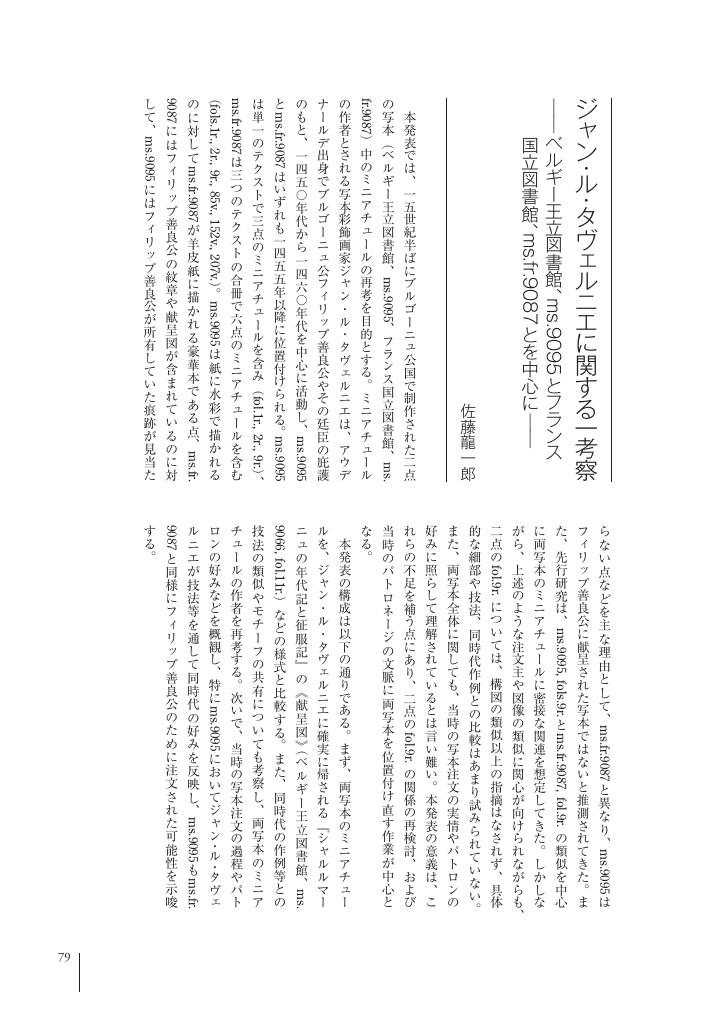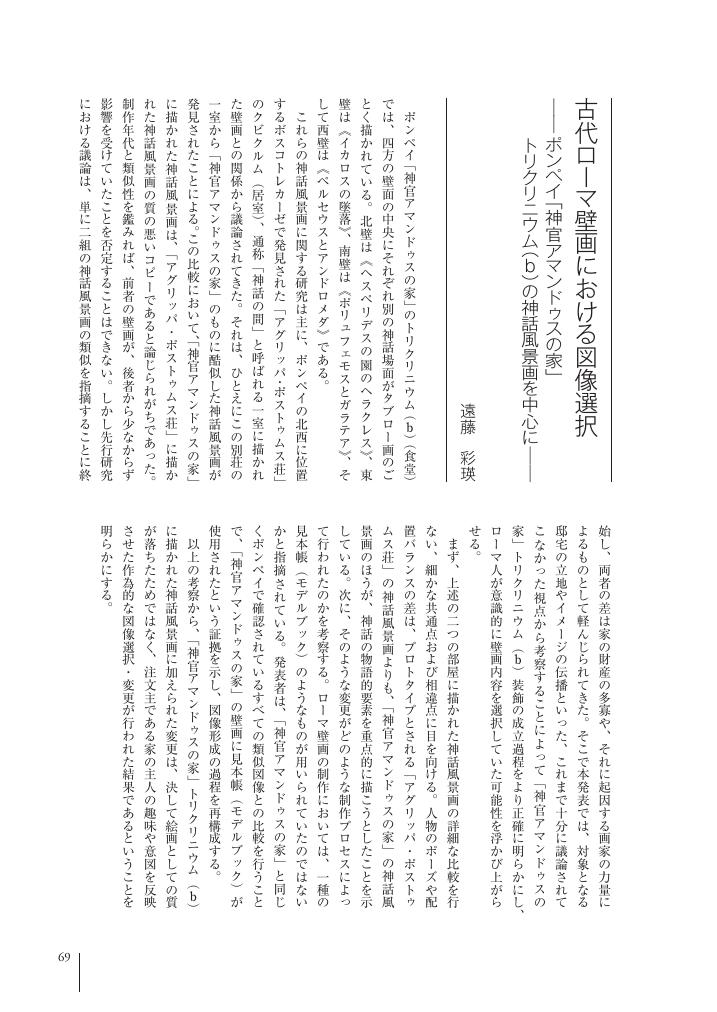1 0 0 0 OA 東松照明と『日本』(一九六七年) 「群写真」概念の誕生と発展を辿る、 遡及的読解の試み
- 著者
- 北澤 周也
- 出版者
- 美学会
- 雑誌
- 美学 (ISSN:05200962)
- 巻号頁・発行日
- vol.69, no.2, pp.77, 2018 (Released:2020-03-23)
1 0 0 0 OA 音楽のうちに悲しみを聴く
- 著者
- 源河 亨
- 出版者
- 美学会
- 雑誌
- 美学 (ISSN:05200962)
- 巻号頁・発行日
- vol.69, no.2, pp.78, 2018 (Released:2020-03-23)
- 著者
- 佐藤 龍一郎
- 出版者
- 美学会
- 雑誌
- 美学 (ISSN:05200962)
- 巻号頁・発行日
- vol.69, no.2, pp.79, 2018 (Released:2020-03-23)
1 0 0 0 OA ユクスキュルにおける主体概念 「気分(Stimmung)」の観点から
- 著者
- 新松 寛明
- 出版者
- 美学会
- 雑誌
- 美学 (ISSN:05200962)
- 巻号頁・発行日
- vol.69, no.2, pp.80, 2018 (Released:2020-03-23)
1 0 0 0 OA アーニョロ・ブロンヅィーノ作《甲冑姿のコジモ一世の肖像》 (ウフィツィ美術館)再考
- 著者
- 瀬戸 はるか
- 出版者
- 美学会
- 雑誌
- 美学 (ISSN:05200962)
- 巻号頁・発行日
- vol.69, no.2, pp.81, 2018 (Released:2020-03-23)
1 0 0 0 OA デザインと素描 官立デザイン学校における 素描教育の系譜
- 著者
- 竹内 有子
- 出版者
- 美学会
- 雑誌
- 美学 (ISSN:05200962)
- 巻号頁・発行日
- vol.69, no.2, pp.82, 2018 (Released:2020-03-23)
1 0 0 0 OA 映像のなかのスクリーン リアプロジェクションをもちいた多層的映像をめぐって
- 著者
- 大﨑 智史
- 出版者
- 美学会
- 雑誌
- 美学 (ISSN:05200962)
- 巻号頁・発行日
- vol.69, no.2, pp.37, 2018 (Released:2020-03-23)
Rear projection is one of the most frequently used compositing techniques in Hollywood cinema from the 1930s to the late 1960s. Nevertheless, this technique has been hitherto underestimated. Of the scarce existing research, some studies have pointed out the economic advantages of it in terms of the studio system of the day, while others have examined it in the limited context of certain films or film directors. But such approaches have not paid sufficient attention to the fact that the many films had used the technique in spite of harsh criticism regarding the resultant image quality. This paper aims to clarify in part how the images created through rear projection were interpreted by the audiences of the time. The images were surely lacking in terms of the “reality” pursued by classical Hollywood cinema. However, the audiences were able to understand the mechanism of rear projection and experience its effects in a mode separate to that supposed by the classical Hollywood cinema. By analyzing a moving vehicle scene, I demonstrate how the gap created between foreground and background in the images re-arouses wonder in the audience, allowing them to enjoy the medium of cinema as a visceral attraction.
1 0 0 0 OA オズワルド・ヂ・アンドラーヂの 批評基準について 「ブラジル性」を中心に
- 著者
- 居村 匠
- 出版者
- 美学会
- 雑誌
- 美学 (ISSN:05200962)
- 巻号頁・発行日
- vol.69, no.2, pp.67, 2018 (Released:2020-03-23)
1 0 0 0 OA ミニマル・アートにおけるコレクターの役割 ロバート・モリスとジュゼッペ・パンザを中心に
- 著者
- 鵜尾 佳奈
- 出版者
- 美学会
- 雑誌
- 美学 (ISSN:05200962)
- 巻号頁・発行日
- vol.69, no.2, pp.68, 2018 (Released:2020-03-23)
- 著者
- 遠藤 彩瑛
- 出版者
- 美学会
- 雑誌
- 美学 (ISSN:05200962)
- 巻号頁・発行日
- vol.69, no.2, pp.69, 2018 (Released:2020-03-23)
1 0 0 0 OA 高松次郎「複合体」シリーズ そのドローイングとの関連性より
- 著者
- 大澤 慶久
- 出版者
- 美学会
- 雑誌
- 美学 (ISSN:05200962)
- 巻号頁・発行日
- vol.69, no.2, pp.70, 2018 (Released:2020-03-23)
1 0 0 0 OA 身体と言語の関係について 人間のmovementと言語に関する 実験に基づく考察
- 著者
- 柿沼 美穂
- 出版者
- 美学会
- 雑誌
- 美学 (ISSN:05200962)
- 巻号頁・発行日
- vol.69, no.2, pp.71, 2018 (Released:2020-03-23)
1 0 0 0 OA 分析プラグマティズム美学事始め まずは「経験」から
- 著者
- 加藤 隆文
- 出版者
- 美学会
- 雑誌
- 美学 (ISSN:05200962)
- 巻号頁・発行日
- vol.69, no.2, pp.72, 2018 (Released:2020-03-23)
1 0 0 0 OA 明治期の日本における〈人形〉観の複層性 文字資料を用いた再検討
- 著者
- 兼内 伸之介
- 出版者
- 美学会
- 雑誌
- 美学 (ISSN:05200962)
- 巻号頁・発行日
- vol.69, no.1, pp.153, 2018 (Released:2019-06-01)
- 著者
- 青木 孝夫
- 出版者
- 美学会
- 雑誌
- 美学 (ISSN:05200962)
- 巻号頁・発行日
- vol.69, no.1, pp.154, 2018 (Released:2019-06-01)
1 0 0 0 OA 生人形とマネキン、彫刻 作品構造と文脈からみる特質
- 著者
- 本田 代志子
- 出版者
- 美学会
- 雑誌
- 美学 (ISSN:05200962)
- 巻号頁・発行日
- vol.69, no.1, pp.155, 2018 (Released:2019-06-01)
1 0 0 0 OA 「自動人形」の歌と踊り
- 著者
- 長野 順子
- 出版者
- 美学会
- 雑誌
- 美学 (ISSN:05200962)
- 巻号頁・発行日
- vol.69, no.1, pp.155-2, 2018 (Released:2019-06-01)
1 0 0 0 OA 人形と美学 「言語ゲーム」的文脈での人形遊びの解釈
- 著者
- 岡林 洋
- 出版者
- 美学会
- 雑誌
- 美学 (ISSN:05200962)
- 巻号頁・発行日
- vol.69, no.1, pp.155-3, 2018 (Released:2019-06-01)
1 0 0 0 OA バレエにおけるアラベスクとグロテスク
- 著者
- 譲原 晶子
- 出版者
- 美学会
- 雑誌
- 美学 (ISSN:05200962)
- 巻号頁・発行日
- vol.69, no.1, pp.121, 2018 (Released:2019-06-01)
The arabesque, a figure symbolic of ballet, was first defined as body attitude by Italian ballet master Calro Blasis. Falcone discusses a strong influence on Blasis’ theory from artists who took inspiration from the frescoes of Herculaneum excavated in the middle of 18th century, when the concept ‘arabesque’ was introduced into dance. This essay revisits the prehistory of arabesque from a different perspective than Falcone’s, focusing the close relation of the decorative art to dance from the 17th century, especially its relation to mascarade and dance notation. With this view, I study texts, in which ‘arabesque’ is referred to, by leading 18-century choreographers Noverre, Dauberval and Pierre Gardel and examine their different interpretations of the term, taking into account the fact that ‘arabesque’ was a synonym of ‘grotesque’ at that time. I also delve into the functions of the constructional elements, lines and figures, of arabesque in the decorative art and how their counterparts of arabesque in ballet work. Finally, regarding arabesque in ballet as a kind of device for transforming the body from a present figure into another, I argue that Blasis’ arabesque could first emerge when the dancing body was to be made through technique, not through disguise.
1 0 0 0 OA ルートヴィヒ・ノールの《ミサ・ソレムニス》論 「フモリスト」ベートーヴェンの教会音楽
- 著者
- 清水 康宏
- 出版者
- 美学会
- 雑誌
- 美学 (ISSN:05200962)
- 巻号頁・発行日
- vol.69, no.1, pp.133, 2018 (Released:2019-06-01)
In the 19th century Beethoven’s Missa Solemnis was criticized for not being suitable for a church service because of its large-scale orchestration and difficulty in a vocal part. Ludwig Nohl, a music critic who was around “the new German school,” however, argued the significance of this Mass as the religious music and the religious manner of the composer, instead of discussing its usability in the worship of the church. He considered Missa Solemnis as “Scheinmesse (apparent Mass)” which was dissolved into a merely aesthetic appearance. It was because that the “transcendent” mindset of the composer never realized the beauty which was not “apparent” but concrete or “immanent” and was for the German people. This mindset was created from the personality of this composer as “Humorist.” In this Mass, Nohl found the expression of the complex mind which modern artists had. The precedent studies show that Nohl only evaluated this Mass negatively, but in this paper, I examine his document in more detail and explore how he actually thought about the significance of this Mass.
















